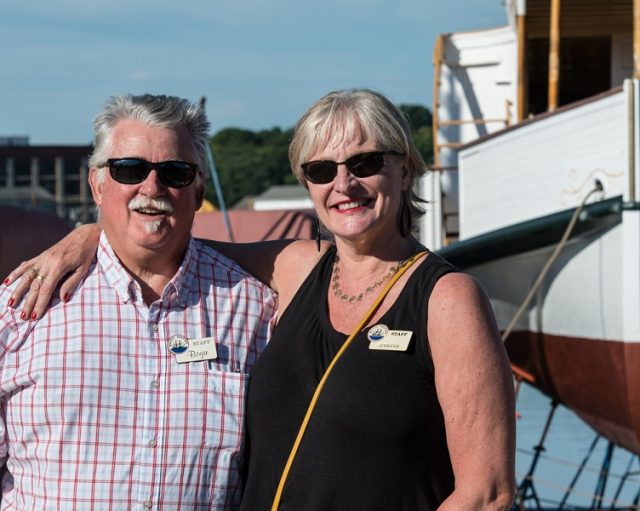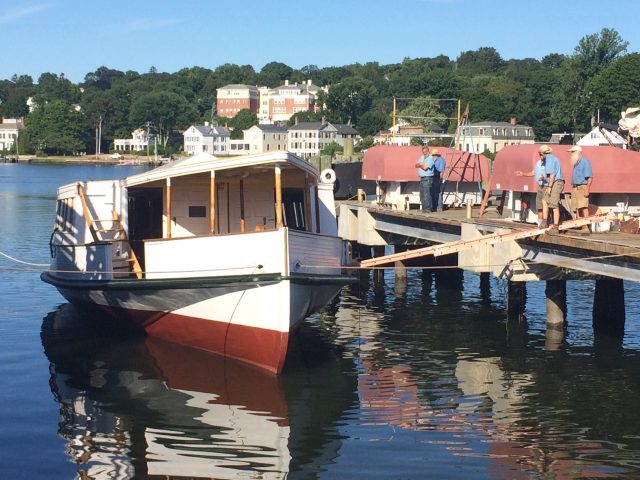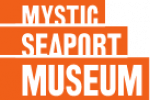Author: Mystic Seaport Museum
Museum Celebrates “History on the Half Shell” with Food, Music, and Fun
Mystic, Conn. (September 15, 2016) — Mystic Seaport will host the first ever Mystic River Oyster Festival on Saturday, October 1. The festival is a new event to celebrate the history, growing, and cuisine of the popular shellfish in Mystic and southern New England.
The Museum is opening its grounds to a variety of growers, restaurants, educational and advocacy organizations, and others with an interest in the cultivation, conservation, heritage, and eating of oysters. Visitors will be able to sample all sorts of oysters, both raw and in prepared dishes.
Participants include Mystic’s Oyster Club and Engine Room, the Noank Aquaculture Cooperative, Matunuck Oyster Bar, Fishers Island Oyster Farm, Behan Family Farms, Broad Street Kitchen, Jonathan Island Oyster Co., Norm Bloom & Son’s Copps Island Oysters, and Coastal Gourmet.
Mystic Knotworks and R. Murphy knives will be on hand to sell their wares.
Connecticut Sea Grant, Save the Bay, and CUSH (Clean Up Sound and Harbors) will be present to share information on aquaculture, shellfish conservation efforts, and clean water initiatives in Long Island Sound and Narragansett Bay. Guest speakers from the Noank Oyster Cooperative and The Nature Conservancy will give presentations on oyster farming, aquaculture, and ocean preservation.
Throughout the day, the Museum’s historic interpreters will offers talks and demonstrations on the history of oystering and New England fisheries, and visitors can check out the Thomas Oyster House exhibit, the 1891 oyster sloop Nellie, and take in an oyster-shucking contest.
Live music will be provided by local musicians Craig Edwards and Don Sineti.
The festival will run from 9 a.m. to 5 p.m. Food service will be from 11 a.m. to 5 p.m. The Mystic River Oyster Festival is free with regular Museum admission. Food is subject to an additional charge.
About Mystic Seaport
Mystic Seaport is the nation’s leading maritime museum. Founded in 1929, the Museum is home to four National Historic Landmark vessels, including the Charles W. Morgan, America’s oldest commercial ship and the last wooden whaleship in the world. The Museum’s collection of more than two million artifacts includes more than 500 historic vessels and one of the largest collections of maritime photography in the country. The state-of-the-art Collections Research Center at Mystic Seaport provides scholars and researchers from around the world access to the Museum’s renowned archives. Mystic Seaport is located one mile south of Exit 90 off I-95 in Mystic, CT. Admission is $26 for adults and $17 for children ages 6-17. Museum members and children 5 and under are admitted free. For more information, please visit https://mysticseaport.wpengine.com/ and follow Mystic Seaport on Facebook, Twitter, YouTube, and Instagram.
Mystic, Conn. (September 12, 2016) — On September 24, 2016, Mystic Seaport will celebrate the opening of the Thompson Exhibition Building, an event that ushers in a new era at the Museum and completes a transformation of the north end of the grounds that will enhance and increase the Museum’s capacity to succeed in its mission to inspire an enduring connection to the American maritime experience.
There will be a brief ceremony to commemorate the occasion at 9 a.m. on the Cambridge Plaza, the public space in front of the building, after which visitors will be invited inside to explore the structure for the first time.
“The opening of the Thompson Exhibition Building is the culmination of many years of work and the fulfillment of a vision to focus on the display of our collections in ways we have never been able to do before,” said Steve White, president of Mystic Seaport. “This increase in our exhibition capacity creates a more robust year-round experience for the visitor, which makes this project not just an investment in the future of Mystic Seaport, but also an investment in the future of tourism for the entire region.”
The Thompson Building is the cornerstone and final element of the McGraw Gallery Quadrangle, which integrates existing buildings and grounds with new construction and unifies the components of the north end of the Museum by focusing on their common role as formal exhibition galleries.
Named for the late Wade Thompson, a Mystic Seaport trustee for 27 years who believed passionately in the need for new, state-of-the-art exhibition space and its importance for the future of the Museum, the 14,000-square-foot building will house the Collins Gallery, a 5,000-square-foot hall featuring soaring ceilings and a flexible layout to accommodate objects of varying size and installations of all types. This will be the largest among the Museum’s seven formal galleries and will provide the caliber of conditions required to curate not only exhibits from the Mystic Seaport collections, but also permit the borrowing of outstanding art and artifacts from other museums around the world. A riverfront meeting space, the Masin Room, graces the west side of the building and can be reconfigured for conferences or lectures, additional gallery space, or educational programs adding to its versatility.
The building incorporates a wraparound deck that will allow visitors to enjoy the riverside setting and serve as a covered overlook to the quadrangle’s common area. Other elements include a prominent Museum entrance, a sweeping reception lobby, ticketing center, retail shop, and visitor amenities.
Designed by the Connecticut firm Centerbrook Architects and Planners, the Thompson Building evokes the “geometry of the sea,” drawing design cues from the interior of a wooden ship, the undulating sea, and a spiraling nautilus shell. Construction was managed by A/Z Corporation of North Stonington, CT.
The Thompson Building and McGraw Quadrangle are the result of a decade of strategic and master planning, and will provide:
- An iconic point of arrival at the north end of the campus
- All-weather and all-season operational capabilities
- Sweeping, unobstructed views of the Mystic River
- Outdoor celebration areas for both Museum and community use
- 21st-century upgrades and improved access to existing galleries around the Quadrangle’s perimeter, including those in the Stillman and R. J. Schaefer buildings
- Environmentally responsible features that respond to the riverfront location, including a storm water treatment system and geothermal heating and cooling
- Increased wheeled accessibility for the north campus
- Galleries and venues suitable for schools’ year-round educational visits
The Thompson Building is being funded through private and public sources, including generous support from individual philanthropists and foundations, the Thompson family, and a $2 million grant from the State of Connecticut.
Inaugural Exhibit
The inaugural exhibit in the Collins Gallery, SeaChange, will open on December 10, 2016. The exhibit presents a range of beautiful and unique objects drawn from the vast collections of Mystic Seaport. Each object is a survivor of the past that speaks to a notable transformation – in material, technology, the sea itself, or the broader American culture over the past 200 years. A handful of these intriguing artifacts will be on display for the first time, and all will be presented in a new setting which reveals surprising stories. Together, they give glimpses into people’s lives in different places and times, from scientific surveyors charting the Atlantic coast on the eve of the American Revolution to western merchants trading for silk and tea in 1850s China, from Arctic explorers to laborers harvesting bird guano off Peru for American farmers. The stories of transformation they relate continue to impact a contemporary audience and its experience with the sea.
About Mystic Seaport
Mystic Seaport is the nation’s leading maritime museum. Founded in 1929, the Museum is home to four National Historic Landmark vessels, including the Charles W. Morgan, America’s oldest commercial ship and the last wooden whaleship in the world. The Museum’s collection of more than two million artifacts includes more than 500 historic vessels and one of the largest collections of maritime photography in the country. The state-of-the-art Collections Research Center at Mystic Seaport provides scholars and researchers from around the world access to the Museum’s renowned archives. Mystic Seaport is located one mile south of Exit 90 off I-95 in Mystic, CT. Admission is $26 for adults and $17 for children ages 6-17. Museum members and children 5 and under are admitted free. For more information, please visit https://mysticseaport.wpengine.com/ and follow Mystic Seaport on Facebook, Twitter, YouTube, and Instagram.
Free Admission for Children All Day
Mystic, Conn. (September 1, 2016) — Mystic Seaport announces Citizens Bank will be hosting Family Fun Day at Mystic Seaport on Saturday, September 17. Children ages 17 and younger will receive free admission when accompanied by a paying adult.
“Citizens Bank is proud to sponsor the Family Fun Day at Mystic Seaport, bringing the community together for a day of learning and fun the whole family can enjoy,” said Lisa Maass, President, Citizens Bank, Connecticut. “It’s a great opportunity for first-time visitors and frequent guests to spend time at this historic museum and enjoy activities for all ages.”
A quintessential New England experience, Mystic Seaport offers visitors of all ages a unique link to America’s seafaring past and the opportunity to immerse themselves in hands-on history.
In addition to the Museum’s exhibits, historic ships, and 19th-century seafaring village, the schedule for the day includes:
- Face painters, balloon artists and glitter tattoo artists on the Membership patio from 11 a.m. to 3 p.m.
- Activities for children include crafts and games in Home Port, the Discovery Barn, the Children’s Museum, a Navigation Quest scavenger hunt, and the Playscape playground.
- Free lemonade and coffee served in the Membership Building.
- A free cookie from the Bake Shop to all Citizens Bank card holders, compliments of Citizens Bank.
- Rowboat and sailboat rentals, waterfront cruises, toy boat making and Planetarium shows. (Subject to additional fees.)
Adult admission is $26, with a $3 discount for Citizens Bank employees with identification.
About Mystic Seaport
Mystic Seaport is the nation’s leading maritime museum. Founded in 1929, the Museum is home to four National Historic Landmark vessels, including the Charles W. Morgan, America’s oldest commercial ship and the last wooden whaleship in the world. The Museum’s collection of more than two million artifacts includes more than 500 historic vessels and one of the largest collections of maritime photography in the country. The state-of-the-art Collections Research Center at Mystic Seaport provides scholars and researchers from around the world access to the Museum’s renowned archives. Mystic Seaport is located one mile south of Exit 90 off I-95 in Mystic, CT. Admission is $26 for adults and $17 for children ages 6-17. Museum members and children 5 and under are admitted free. For more information, please visit https://mysticseaport.wpengine.com/ and follow Mystic Seaport on Facebook, Twitter, and YouTube.
2016 Library Fellows Awards
Each year, the Fellows of the G.W. Blunt White Library at Mystic Seaport issue awards to recognize significant achievements in maritime heritage writing.
The John Gardner Maritime Research Award is presented by the Fellows of the G.W. Blunt White Library for making a significant contribution in the maritime research field. The award is named for the late John Gardner, author, editor, curator, small-boat designer, builder, regular user of the Library and a proponent of maritime research.
The winner for 2016 is: David Head, Ph.D. for his book Privateers of the Americas: Spanish American Privateering from the United States in the Early Republic, University of Georgia Press, Early American Places Series. 2015.
Head teaches in the History Department at the University of Central Florida. He looks at how Spanish American privateering worked and who engaged in it; how the U.S. government responded; how privateers and their supporters evaded or exploited laws and international relations; what motivated men to choose this line of work; and ultimately, what it meant to them to sail for the new republics of Spanish America. His findings broaden our understanding of the experience of being an American in a wider world.
Each year, the Fellows also bestow a prize upon the author of the best article written in CORIOLIS: The Interdisciplinary Journal of Maritime Studies. This $1,000 prize is named in memory of the former Director of the library and head of publications, Gerald E. Morris. The Morris prize this year was given to Maria Vann for her article in the Volume 5, Number 1, 2015 issue entitled “Sirens of the Sea: Female Slave Ship Owners of the Atlantic World, 1650-1870.”
A graduate of the Cooperstown Graduate Program in Museum Studies, Vann is currently the director of the Marine Museum in Fall River, MA.
Vann notes that throughout the active years of the transatlantic slave trade, some European and American women gained economic and social influence by involvement as participants in the slave trade. They challenge the dominant narrative that the slave trade was practiced exclusively by white men. Her article focuses on female slave traders from Britain and American colonies during the period of 1650-1760, with a concentration on New York, the former Dutch colony that fell under English rule after 1764.
Her research is largely based on review of the Trans-Atlantic Slave Trade Database, slave ship records, newspapers, journals, court records and diaries. Sources were evaluated with intentional focus on women who were previously overlooked. The existence during the early years of the transatlantic trade challenges common notions about both gender and the slave trade and additionally raises important questions about the role of women slavers in other times and places.
“A fascinating study, this article is a well-deserving winner of the Morris Prize Article Contest,” said Paul O’Pecko,Vice President, Research Collections and Director of the G.W Blunt White Library at Mystic Seaport.
Thompson Building Opening
Hinckleys to Rendezvous at Mystic Seaport
Mystic Seaport will be the first destination for this year’s Hinckley Rendezvous with more than 20 of the iconic Hinckley picnic boats, and 70 guests, visiting the Museum August 4-5. During their stay, Hinckley owners will tour the Museum’s Collections Research Center viewing photographs from the Rosenfeld Collection and artifacts relating to the schooner America. In addition, a tour of the Henry B. duPont Preservation Shipyard will be given as well as a special tour of the exhibit “Over Life’s Waters” featuring the art collector Charles Hamm.
Following the Mystic Seaport events, Hinckley owners will travel to Newport for the second leg of the Rendezvous. A parade of boats is planned for the 9:40 bridge Friday morning. The Hinckley Rendezvous was chaired by Mystic Seaport Trustee Grant Cambridge and his wife Peggy. It is an example of the Museum’s Mystic Affinity Program (MAP), which is new strategy the Museum is using to introduce new people to the Museum and to the region through events hosted by members and friends of Mystic Seaport.
Hinckley Yachts, headquartered in Portsmouth, Rhode island, is known for the beauty and craftsmanship of their boats. Hinckley builds a variety of motor and power yachts through the Hinckley Yachts, Hunt Yachts and Morris Yachts brands, which are distributed worldwide.
What’s Your SABINO Story?

Throughout Sabino‘s restoration over the last 20 months, we have been hearing a number of stories from people who had a special moment in their life on board the steamboat, usually on the 90-minute downriver evening cruise. That got us thinking: How many people out there have a similar story? Whether it be a first date, a proposal, or just that moment when something important fell into place, Sabino seems to have been the catalyst, or at least the setting, for more than her share. Do you have a Sabino story? If so we would like to hear it. Please email us or call 860.572.5307. The following is the story Jennifer and Fed Bogue recently shared:
Last year, for their 35th wedding anniversary, Jennifer Bogue tried to book a downriver cruise as a surprise for her husband Fred. That’s when she found out that the Sabino was out of the water undergoing restoration in the Museum’s Shipyard.
Sabino holds a special place in the heart of the Bogue family. Jennifer and Fred had their first date on one of the downriver cruises in 1977. Jennifer had just started as a hostess at the Museum’s Seamen’s Inne and met Fred, who worked as a line cook. Fred had never been on Sabino before and Jennifer had only worked a few parties on board, pouring wine, helping with food service, and, in her words, “not actually sitting there and enjoying the ride.”
At that time the Seamen’s Inne Restaurant (now Latitude 41° Restaurant & Tavern) was fully owned and operated by Mystic Seaport, so Jennifer and Fred were employees and still have their 1970s-era badges.
As Jennifer explained, “We could come and go at Mystic Seaport anytime we wanted. That’s why the Sabino trip was a very reasonable date! We made prime-rib sandwiches at work and brought a bottle of wine and some strawberries. We sat on the back and it was a lovely date… it was a down-river cruise, a sunset cruise.“
The Bogues continued to work on and off at the Seamen’s Inne over the next decade, during which they got married, Fred attended culinary school, and they had children. Fred found his way into carpentry by helping rebuild the oyster bar at the restaurant during the slow winter season. He said, “I helped the gentleman do a lot of demo work. I became friendly with him and he gave me my first carpentry job.”
Leaving the restaurant business shortly before their marriage in 1980, Fred stayed in the carpentry business for over 20 years. In 2004, the couple opened the Bogue’s Alley Deli in Pawcatuck, named after the area near Fort Rachel in Mystic where Fred’s family lived. Fred’s father worked as a welder for Electric Boat and they recently learned that he may have helped build another Mystic Seaport vessel, the tugboat Kingston II. Today, the deli is owned by a former employee and Fred has returned to doing small-craft carpentry.
SABINO Launched

After nearly 20 months out of the water for restoration in the Shipyard, steamboat Sabino was launched early in the morning Wednesday, July 27. She previously had been staged on the shiplift and once the motors were engaged she was lowered into the water in a process that took around 15 minutes. She floated off her stands at 8:29 a.m.
Prior to the launch, Mystic Seaport President Steve White addressed the gathered staff and volunteers to thank those who had worked on the project and to announce that the Museum had begun the design process for a new boiler.
“If all goes well, we expect Sabino will again be steaming on the Mystic River next summer,” he said. He noted that fundraising continues and encouraged anyone who would like to support the effort to return the vessel to operation to contact the Museum’s Advancement Department.
Sabino is still missing her canopy top, pilot house, stack, and engine, so she looks somewhat cut down at present. Since the boiler project is moving forward faster than expected, those parts will not be re-installed until the new boiler is fabricated and delivered. Installation of the boiler requires it to be lowered through a “soft patch” in the top deck (a section of the deck that can be removed much like a hatch) and the canopy would have to be removed as well. The Shipyard staff determined it made more sense to hold off on that work until the boiler was ready so there would not be unnecessary duplication of effort. Thus, Sabino will remain in the Shipyard until the project is complete and she is ready to resume operation.
Sabino was built in 1908 in East Boothbay, ME, and spent most of her career ferrying passengers and cargo between Maine towns and islands. She is 57 feet long and has a beam of 23 feet. Her hull is constructed of wood and she is powered by a 75 horsepower two-cylinder compound steam engine—the very same engine that was installed in 1908. The engine was constructed in nearby Noank. Her boiler is fueled by burning coal.
She came to Mystic Seaport in 1973, where she takes visitors on 30- and 90-minute cruises on the Mystic River from Memorial Day weekend to Columbus Day each year.
While she has received constant maintenance and work since she was purchased by Mystic Seaport in 1974, she had reached a point in the life of the vessel where a thorough restoration was needed to keep her operating for future generations.
“The goal is to make Sabino good for the next 25 years,” said Shipyard Director Quentin Snediker at the beginning of the project.
The restoration is supported by a mix of public and private sources, including a $199,806 Maritime Heritage Grant administered by the National Park Service, $149,000 from the Institute of Museum and Library Services’ Museums for America grant program, and $172,125 from the Connecticut State Historic Preservation.Office.
The MORGAN Turns 175
https://youtu.be/du0QQuhEpoQ
On July 21, 1841, the Hillman Brothers shipyard in New Bedford launched their latest whaleship, soon to be named the Charles W. Morgan. Of those present that day, who would have thought that the ship would still be around 175 years later? But after an 80-year career in the whaling fishery, and surviving hurricanes, icebergs, neglect, and 38 Voyages that spanned the globe–the latest in 2014–the Morgan is still afloat and still telling the story of America’s maritime heritage. Here’s to 175 more years!
Image Gallery
Click on the first image to start a slide show.


